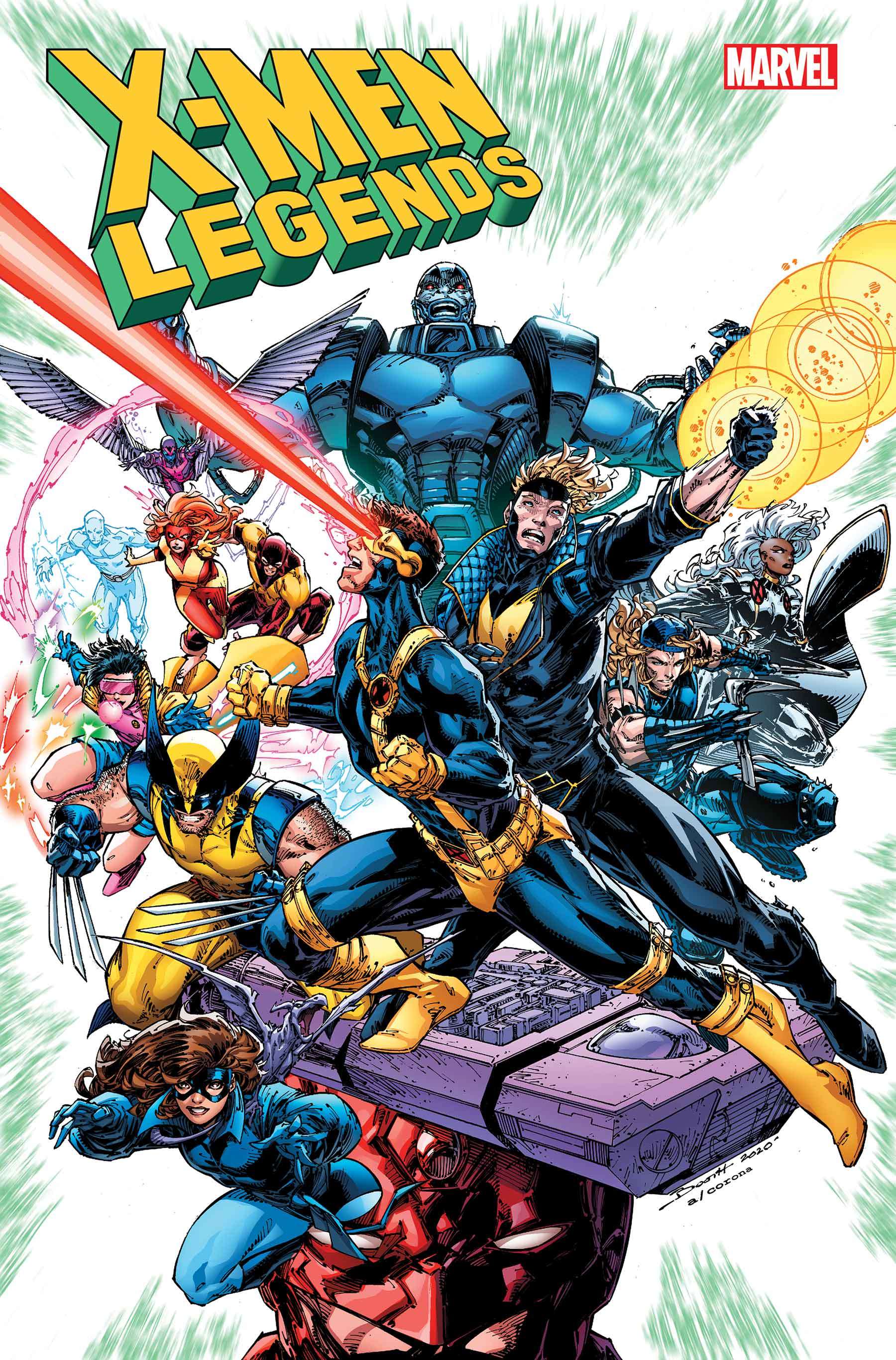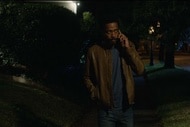Create a free profile to get unlimited access to exclusive videos, sweepstakes, and more!
Comics Wire: DC's new editor-in-chief, and Marvel's X-Men Legends. Plus this week's hot reads

Welcome to Comics Wire, SYFY WIRE's weekly comics column that gets at the pulse of what's going on in comics right now. We've got what you need to know about huge crossovers, real-life issues facing the industry, cool first looks, the week's hot new comics, and everything in between.
Over the summer, DC Comics suffered a wave of layoffs amid an ongoing reorganization at WarnerMedia, and for a while there readers were worried that perhaps the DC Universe as we know it would be threatened. While the publisher's slate of projects has, according to publisher Jim Lee, undergone a bit of slimming, Lee also emphasized at the time that comics would remain a "cornerstone" of the company. Now, a key DC hire seems to underline that commitment.
DC Comics General Manager Daniel Cherry III announced this week that Marie Javins, who previously served as interim editor alongside Michele Wells during the reorgnization, has been promoted to editor-in-chief of the publisher's entire line. After six years with the company, during which she's presided over some of its most important comics projects, Javins will now head-up all things DC Comics, reporting to Cherry and working alongisde Jim Lee to craft DC's pubishing schedule going forward.
There's a reason you may have seen many of the biggest names in comics celebrating the news on Twitter earlier this week, and that's that Javins is very, very good at what she does. She's worked at big and small publishers alike throughout her career, she's edited books ranging from superhero epics to smaller, more intimate projects, and as a colorist she worked on hundreds of pages of comics on a panel-by-panel level, so she understands everything that goes into the books in a very fundamental way.
She has amazing taste, as evidenced by the projects she's edited at DC -- which include everything from Exit Stage Left: The Snagglepuss Chronicles to Superman Smashes The Klan and Dark Nights: Death Metal -- and she also has an eye toward growing readership, something she's pushed for through her work with DC's ever-growing digital pubishing arm and through initiatives like DC Super Hero Girls. Put simply, if DC Comics is going to thrive in an ever-changing market it needs an editor who understands all the things comics can be, and all the ways comics can reach readers. Marie Javins is that kind of editor, and it'll be thrilling to see what her tenure at the helm of DC looks like in the months to come.
Marvel's X-Men Legends
So much of the story of modern comics is a story of trying to find the often delicate balance between old and new, familiar and fresh. It's a balance that's hard to strike, and sometimes things swing so wildly in one direction or another that it's hard to tell the effort is there at all, but it's something that defines a lot of the modern superhero comics market, and it's fascinating to watch publishers work to try to maintain it.
All of which is to say that you may have noticed X-Men comics looking and feeling a bit different in the last year or so. The Dawn of X era promised a reinvention, and that's what we got, a major reorganization of Marvel's mutant population that nevertheless also hinged on a lot of things from the past remaining relevant. Then things moved into X of Swords territory and, for some readers, it might have been just a little too much (I should be clear: Not me. I love that stuff.) reinvention. Well, if you're in that category, or you just really love '80s and '90s X-Men stories, Marvel's got something cooking for you.
On Tuesday the publisher announced X-Men Legends, a new line of "in-continuity" stories from some of the greatest creators in X-Men history that hope to "resolve long-standing plot danglers, and reveal shocking truths that will change the past and future of the X-Men." In that spirit, the first story to come out of this new line, from writer Fabian Nicieza and artist Brett Booth, will very appropriately tackle the story of the "third" Summers brother, Adam-X.
"It's incredibly exciting to finally tell the story of the infamous 'third' Summers brother. Twenty-five years in the making, to see the truth about Adam-X revealed – and drawn so magnificently by Brett Booth – is one of the most surreal experiences of my career!” Nicieza said in a press release. “Getting the opportunity to tell this tale while kicking off the new X-Men Legends series is a x-tremely x-citing!”
Other stories in the Legends line have not yet been announced, but some of the creators have, and they include Marvel all-stars like Chris Claremont, Peter David, Larry Hama, and arguably the most unsung hero in all of X-Men history, Louise Simonson. At first glance, it might sound a little like retro stories for the sake of retro stories, but consider this: There's nothing necessarily wrong with that, and these stories could turn out to have some really interesting implications, particularly if they're really serious about digging deep into further mutant mysteries.
X-Men Legends begins in February.
More news: Young Hellboy, The Maxx Calendar, and more!
- Hey, have you started your holiday shopping yet? Do you know anyone who loves Sam Keith's legendary reality-hopping comic The Maxx? Well, Keith just dropped a perfect gift idea in the form of a new calendar celebrating the classic series and its title character, now seeking backers on Kickstarter. The calendar will ship next month for all your 2021 date-marking needs, and features both pre-existing pieces of The Maxx art and new pieces from Keith. You can get your copy (or a copy for a loved one who'd love to unwrap it) for 25 bucks.
- One of the best things about Mike Mignola's Hellboy is that you can seemingly take the character just about anywhere, and since he's led such a long and rich life there are still numerous potential chapters to be explored, including the adventures of Big Red as a young man. Earlier this week Dark Horse Comics announced that next year Mignola, co-writer Tom Sniegoski, and artist Craig Rousseau are setting out to do just that with Young Hellboy: The Hidden Land, a four-issue series set in 1947 that promises a lighter tone compared to other Hellboy fare. Which, of course, means it could be the perfect thing for the budding Hellboy fan in your life. The series launches in February.
- Last week, writer Stephanie Phillips launched the compelling new AfterShock Comics series Red Atlantis. This week, AfterShock revealed that Phillips is teaming with the publisher once again next year for her fourth title with them, Nuclear Family. Adapted from the Philip K. Dick story "Breakfast at Twilight" and featuring art by Tony Shasteen, the series will follow a family in the Cold War who are plunged into alternate history when the nukes start dropping, American survivors are forced underground, and the world becomes a deadly mass of uncertainty. The first issue arrives February 24, and you can check out an early preview over at AfterShock's website.
- Oh, and if you've been among the many fans who were a bit worried when Michel Fiffe announced he was no longer publishing single issues of his beloved comic COPRA with Image Comics, good news: COPRA isn't going anywhere except back to its self-publshing roots. Fiffe has a new interview over at The Beat where he clears up any confusion.
New Comics: Miskatonic debuts, Punchline one-shot, TKO's next wave, and more!
That's the news. Now let's take a look at some of the comics I got excited about this week.
Miskatonic #1: It's a good time for reexaminations of the mythos of H.P. Lovecraft, both in terms of the supernatural hugeness of the author's fiction and the often deplorable personal ideals of the man himself. We've seen it through things like Lovecraft Country on HBO, and now writer Mark Sable and artist Giorgio Pontrelli are putting their own spin on Lovecraftian lore in Miskatonic, AfterShock's new series that combines early 20th century detective work with unfathomable darkness lurking in a New England valley.
Taking its name from Lovecraft's own fictional university and river and placing itself on the historical timeline alongside J. Edgar Hoover's rise in Washington DC in the 1920s, Miskatonic chooses as its point-of-view career for this journey into America's shadows a Federal agent named Miranda Keller. She's smart, she's tough, and she's not about to look Hoover's own sexist attitudes get in the way of her investigations. In fact, getting past Hoover might be the easy part, as Miranda heads to a town called Innsmouth to investigate a series of bombings and finds a gruff private detective, a cold reception, and a horrifying fish-monster cult waiting for her.
A lot of first issues would make you wait for the more monstrous aspects of the mythology laid out here to take hold, perhaps saving a big creature reveal for the very last page and then teasing more information out in the second issue. Miskatonic, to its credit, is not one of those comics. Sable's script doesn't give away the whole farm immediately, and there's a lovely tension building throughout Miranda's journey into the strange and crumbling town of Innsmouth, but if you've come for Lovecraftian monster fun, you're going to get that too, and you're going to get it with a healthy dose of commentary on the ways in which Lovecraft himself approached those monsters.
Pontrelli's art -- clean and bright and precise -- wonderfully portrays this descent into darkness, delivering everything from the creepy sallow faces of locals to full-on monster cultists with rich expressiveness, but perhaps the most impressive thing about the whole story is its willingness to both confront Lovecraft's own locales and characters directly and comment on the essential American darkness (racism, sexism, and the need to pin all of our troubles on an existential Other) present in his fiction. Miskatonic is building something big here, and there's enough depth lurking in the pages to keep bringing me back for more.
The Pull: This week comics publisher TKO Studios debuted its third wave of titles in the form of three new series by three great creative teams, and while I think they're all worthwhile in one way or another, I was most impressed and most compelled by The Pull, an ambitious and larger-than-life sci-fi series from writer Steve Orlando and artist Ricardo Lopez Ortiz.
Set in a world where Earth is protected by a group of thirteen high-powered people known as "Horizon agents," The Pull focuses not so much on the mythology behind those agents and their powers, but on what happens when one of them falls from grace at exactly the wrong time. Brenton Demm, the thirteenth Horizon agent, was supposed to be one of the planet's greatest protectors. But an emotionally charged mission left him not a hero, but a survivor of a massacre he helped cause, a massacre that also seemed to herald the end of the world. With just days left, humanity is on the brink, and Demm is given a second chance to save us all.
Ortiz's art seizes the epic ideas at the heart of this story and captivates with every panel, tinging the action with a manga flair that evokes the bombastic, apocalyptic flair of Akira while also never losing its grip on the mythology Orlando's script is laying out. That script is, as we've come to expect from Steve Orlando stories, packed with big ideas, big emotions, and big narrative developments that push the book forward at lightspeed. Sometimes it feels less like a comic and more like a ride you won't be able to get off even if you wanted to (you won't want to), and the result is a relentlessly fun book packed with ambition, enthusiasm, and craft.
Punchline: I've written before about the misconception I think a lot of readers (including, at times, myself) had about Punchline in her initial rollout, and how we sort of all expected another Harley Quinn and instead got something else entirely. James Tynion IV has been playing with those expectations from the beginning, not just with Punchline herself but with his Batman run overall, and the result is an ongoing story that's both delivering the goods in terms of superhero fun while also always reminding us that there's a different way to look at these things. No matter how old the characters and the tropes in which they exist get, there's another prism through which to view them.
Punchline, the new one-shot starring the title character, written by Tynion and Sam Johns and drawn by the great Mirka Andolfo, is another example of exactly that kind of approach to The Joker, Gotham City, and Punchline herself. Though its set in the aftermath of Joker War and centers of the trial of Alexis Kaye (Punchline's real name), the story finds myriad way to zip back and forth in time to show us exactly how Punchline became Punchline, not just in terms of her origin story but in terms of her whole philosophy. We've already seen an abbreviated version of her Joker obsession and subsequent radicalization. Now it's time to dig deeper, and to show us what happens when an interest in someone like The Joker moves beyond fascination and into something more.
Though Tynion and Johns' script has satisfying depth to it, Andolfo's art is the star of the show here. The very nature of the story requires her to chart the emotional course of this young woman as she moves from scared teenager to supervillain media darling and all the often-frightening steps in between, and that means Andolfo has to find different gears of expressiveness for each phase of the Alexis Kaye-Punchline scale, often on the same page. Then on top of that, she has to chart the parallel story of Harper and Cullen Row as they both approach the Punchline problem from different sides, each zeroing in on the allure and the danger of this new Gotham superpersona with their own emotional arc. It's a masterful artistic performance, and it's only enhanced by a script that seeks to both show us as many phases of the title character as possible and lay out an ambitious course for where she might go next. It's a great Punchline story, a great Harper Row story, and a great Gotham City story, and it's got me even more excited about DC Comics in 2021.
Taskmaster #1: With a Black Widow movie on the horizon in which he's set to make his big-screen debut, it makes sense that we're getting a new Taskmaster miniseries right now, and it also makes sense that the miniseries seems determined to keep the character plugged into the Marvel Universe's espionage community. I expected all of that, but I don't know that I expected the new Taskmaster book to be quite this bombastic and entertaining.
One of the joys of Taskmaster is that, since his whole deal is imitating various other characters and their powers and skills based on observation, he's an endlessly adaptable character, both narratively and tonally. Writer Jed MacKay and artist Alessandro Vitti seem to understand this from the jump, because they launch this book with something else I wasn't expecting: Full-blown comedy that embraces Taskmaster's C-list (or D-list, depending on who you ask) villain status to create a story in which he's in over his head from the jump. It's witty, it's light, and it moves like it's got rocket fuel behind it.
There are, to my mind, two keys to this, and the first is Vitti's art. Taskmaster's not taking that hooded skull get-up off anytime soon, and while it's a great look it presents certain expressive challenges for any artist, especially if you're trying to walk the tightrope between funny and thrilling that this book demands. Vitti makes it look easy, delivering on the zany action and the comedic close-ups with flair. MacKay's script is equally adept at juggling these elements, throwing Taskmaster first into one of the strangest chase scenes of his supervillain career, then into a deep, dark spy conspiracy all in the span of one issue. It's a hell of a fun ride, and I'll definitely be picking up the rest of this miniseries.
Scarenthood #1: There was absolutely no way I was going to miss at least trying out a comic with a title like Scarenthood, so I was thrilled when I read the first issue and found that the rest of the book is as entertaining as the name. Horror stories mashed up with the hectic pace of everyday life are always fun when they're well-executed, and in the hands of writer/artist Nick Roche Scarenthood becomes one of the best new spooky comics of 2020.
As the title suggests, the book follows a group of parents linked by the school their children all go to, a school that apparently hides a dark secret. Much of the action of the first issue follows Cormac, a newcomer to the school along with his daughter, as he tries to balance the challenges of single parenthood with the challenges of single parenthood when the new parents at the school aren't always the most welcoming people in the room. Then, of course, there's the challenge of the dark forces lurking in hidden corners of the school that start to wake up when the parents decide to go exploring.
The metaphors Roche is playing with here are both clear and well-articulated, blending the horrors of hectic parenting with the horrors of evil forces lurking in the places you least expect them, but as with so many stories like this what makes Scarenthood a true joy is all in the execution. It's scary, yes, and the first issue packs a satisfying slow-burn that pays off really well by the end, but what I wasn't expecting was just how funny the book is on a sentence-by-sentence level as Roche builds out the personalities of the parents at the school. His art, helped along by Chris O'Halloran's colors, also packs a certain wit that only serves to underscore just how potent the horror elements are when they come into view. Working with often widescreen-style panels to highlight just how big and daunting this little world is to his characters, Roche manages to make the humor and the horror play equally well, sometimes on the same page. Scarenthood is a delight that I can't wait to keep reading.
And that's it for Comics Wire this week. Until next time, remember what John Custer told his son Jesse in the pages of Preacher:
"You gotta be one of the good guys, son: 'Cause there's way too many of the bad."





























